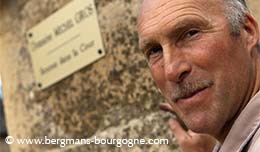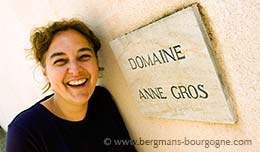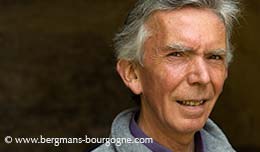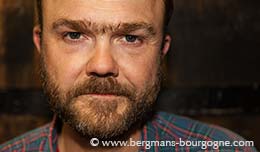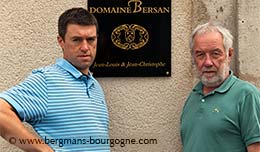
omaine Charton-Vachet is the story of an estate brought back to life. But as is often the case the path there was not straightforward. It involved music, marriage and the city of Nantes in western France before things were up and running again in Saint-Vallerin, one of the villages in the Montagny appellation in the Côte Chalonnaise.
– It is an old domaine, but it was really the creation of my father-in-law, the father of my wife Flo, says Didier Charton-Vachet. Jean Vachet had ten hectares and sold almost everything in bottle. He exported and he sold a lot to restaurants. He retired in 1993.
 There was only one problem. When Jean Vachet decided to retire none of his three children were interested in continuing the family tradition. Up until then there had been winegrowers in the family since the 18th century.
There was only one problem. When Jean Vachet decided to retire none of his three children were interested in continuing the family tradition. Up until then there had been winegrowers in the family since the 18th century.
– Back in the day the family were either winegrowers or stonemasons, says Didier Charton-Vachet. It was like that in every generation. During that era the domaine was small. Wine was not the only thing. Polyculture was how it worked back then.
Since the interest within the family to take on the domaine was limited Jean Vachet decided to set up a leasing arrangement with his two vineyard workers, a father and his son. They did not produce any wine themselves. Instead they sold the grapes to the local cooperative.
 – This went on for 15 years or so, until the father retired. After that his son continued for three or four years. In the end the vineyards were abandoned. It was a disaster. At the time I had ended my job at the Bourgoin-Jallieu Music Conservatory, where I had been deputy director for four years. We had moved to Nantes, where Flo had found a job, but I hadn’t managed to find a job in music.
– This went on for 15 years or so, until the father retired. After that his son continued for three or four years. In the end the vineyards were abandoned. It was a disaster. At the time I had ended my job at the Bourgoin-Jallieu Music Conservatory, where I had been deputy director for four years. We had moved to Nantes, where Flo had found a job, but I hadn’t managed to find a job in music.
With the vineyards abandoned and himself out of a job Didier Charton-Vachet began toying with the idea of switching careers. It may seem like a major leap moving from a career in music, specialising in the field of baroque and renaissance music, to becoming a winegrower in the Côte Chalonnaise. But the thought had crossed his mind before, much thanks to his grandfather who was also a winegrower.
 – So I went to wine school for a year and arrived back at the domaine in November 2009. The following year I did my first harvest. The first years we delivered the grapes to the cooperative since we had to fulfil the contract, but it didn’t work out very well. Then, in 2013, it was the first vinification.
– So I went to wine school for a year and arrived back at the domaine in November 2009. The following year I did my first harvest. The first years we delivered the grapes to the cooperative since we had to fulfil the contract, but it didn’t work out very well. Then, in 2013, it was the first vinification.
2013 was also the year of the birth of their first daughter, Théophanie. A parcel of vines was chosen and the Montagny, Cuvée Théophanie, saw the light of day. Later, their second daughter Ysabeau would lend her name to the Montagny premier cru, Les Jardins d’Ysabeau.
 – Les Jardins is not a very large climat, says Didier Charton-Vachet. You’ll find it between Montagny-les-Buxy and Saint-Vallerin. It’s next to Les Coères, which is large and is facing in almost all directions. Les Jardins is just facing one direction, almost straight north, on a small slope. The soil is surprisingly different from Les Coères, even if they are right next to each other.
– Les Jardins is not a very large climat, says Didier Charton-Vachet. You’ll find it between Montagny-les-Buxy and Saint-Vallerin. It’s next to Les Coères, which is large and is facing in almost all directions. Les Jardins is just facing one direction, almost straight north, on a small slope. The soil is surprisingly different from Les Coères, even if they are right next to each other.
Les Coères at Domaine Charton-Vachet is tiny in terms of quantity. As it says on the label – La µCuvée – it is really a micro-cuvée. One barrel, that is the annual production of this wine.
– Since 2017 it is made in barrel. Not new oak though. I use one-year-old barrels.
There is also Le May, a village appellation Montagny, which is basically inside the village of Saint-Vallerin, just across the street from the domaine.
 – In Le May the soil is deeper, which is often the case with village appellations. The premier crus usually have less soil and the bedrock is closer to the surface. At the bottom of Les Jardins it is even difficult to plant anything.
– In Le May the soil is deeper, which is often the case with village appellations. The premier crus usually have less soil and the bedrock is closer to the surface. At the bottom of Les Jardins it is even difficult to plant anything.
Since the 2019 harvest the domaine is certified organic.
– I have always ploughed the vineyards, explains Didier Charton-Vachet. When I arrived here my father-in-law just said ”You’re nuts!” when he saw what I was doing. For the past seven years I have used the Poussard pruning method. In order to make good wine you need good grapes. And to have good grapes you to pay attention to the needs of the vines.
The only red of the domaine is the Bourgogne Côte d'Or, Cuvée des Henri. It is also the only vineyard outside the Montagny appellation. It comes from a lieu-dit in Nuits-Saint-Georges, Les Grands Chaliots. You’ll find it south of the town and to the immediate east of the D974 road.
 – It is my grandfather’s vineyard. It is 0.60 hectare, with low yields. Since the tanks are closed concrete ones I can’t do any punch-downs. I de-stem 90 per cent. In a good year I add 10-15 per cent whole bunches in order to add some structure. It is not a Nuits or a Vosne. It is a Bourgogne, an easy-drinking wine.
– It is my grandfather’s vineyard. It is 0.60 hectare, with low yields. Since the tanks are closed concrete ones I can’t do any punch-downs. I de-stem 90 per cent. In a good year I add 10-15 per cent whole bunches in order to add some structure. It is not a Nuits or a Vosne. It is a Bourgogne, an easy-drinking wine.
– My grandmother and grandfather in Prémeaux-Prissey had one hectare of vines, a few hectares of cereal crops, a camping and some cows. Very typical for how it was at the time.
Montagny is a large appellation. It’s all chardonnay across 350 hectares, of which 210 hectares are premier crus. In terms of exposure there are vineyards facing in all directions – south, west, north and east – creating wines with different characteristics. Trying to sum up the character of Montagny Didier Charton-Vachet finds it far from easy.
– It’s a difficult question, he says. I’m not sure how to answer it in a simple way. Montagny is interesting because it’s a kind of Burgundian crossroads. You find all the characteristics of the white wines of Burgundy here. You have the fruit of the Mâconnais. There is the acidity, but not as extreme as in Chablis. In appellations like Meursault and Puligny-Montrachet you have wines with lots of structure and length. It’s not on the same level, but there is the same kind of character in Montagny. A wine like a Montagny Les Coères is both structured and has a nice length.
© 2022 Ola Bergman










